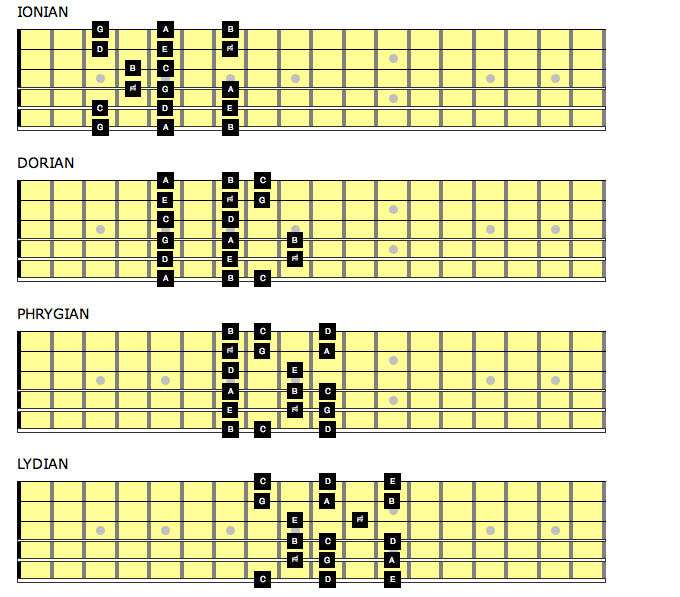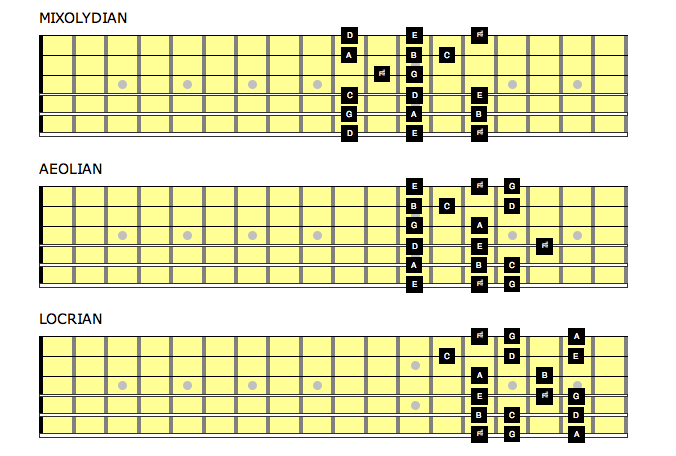Printable Version of Topic
Click here to view this topic in its original format
GMC Forum _ PRACTICE ROOM _ Scale Shapes
Posted by: Satchstet Sep 6 2011, 02:17 AM
So I'm wanting to get even better at knowing where I am on the fingerboard and how to play over key changes......like E Ionian to E Lydian for example. I've been thinking a lot about how to approach this and i have discovered something. The pentatonic shapes and diatonic shapes as I have learned them don't mesh very well thanks to the interval between the G and B string. Sooooooo......to compensate for this I have decided to modify the diatonic scale shapes. They will be 3 nps on the E A D strings and then 2 nps on the B string and then back to 3 nps on the B and E strings. This makes it to where I can then "overlay" the diatonic shape on the pentatonic shape and i don't have to shift "out of position" when I play the straight 3 nps shapes. Pretty damn handy I think. It makes it A LOT easier to slip in and out of pentatonic and diatonic playing when doing this.
I've never seen diatonic scales taught like this. I've only seen them taught 3nps with the position shift on the B and E strings and I've seen the CAGED method where there are only 5 positions taught....even though there are 7 notes in the diatonic scale. The CAGED system also has 2nps on inconsistent strings as well.....sometimes on the B string sometimes on the A string etc......no consistency. Anyways just a little revealation I had when trying to switch between the diatonic and pentatonic scale. It makes it easier to stick to the "safe" notes of the pentatonic scale but know quickly where the "color" notes of the diatonic scale is so you can spice up your playing........ ![]()
Posted by: Michael AC Sep 6 2011, 02:35 AM
I've never seen diatonic scales taught like this. I've only seen them taught 3nps with the position shift on the B and E strings and I've seen the CAGED method where there are only 5 positions taught....even though there are 7 notes in the diatonic scale. The CAGED system also has 2nps on inconsistent strings as well.....sometimes on the B string sometimes on the A string etc......no consistency. Anyways just a little revealation I had when trying to switch between the diatonic and pentatonic scale. It makes it easier to stick to the "safe" notes of the pentatonic scale but know quickly where the "color" notes of the diatonic scale is so you can spice up your playing........
Would mind putting up an example? Maybe use the scale generator? Thanks.
Posted by: Satchstet Sep 6 2011, 03:40 PM
Here are the scale shapes in the key of G major. Nothing revolutionary but I've never seen diatonic scales presented like this.....I've only seen the straight 3nps and CAGED shapes. These to me are just much more handy when using them in conjunction with the pentatonic shapes......especially on the B and high E strings.......


Posted by: Daniel Realpe Sep 6 2011, 03:49 PM
I think the CAGED system is good for knowing your fretboard and know where you are so to speak. But for technical suitability it's good to know the 3nps patterns, then you realise both converge,
Posted by: Satchstet Sep 6 2011, 03:58 PM
I never realized the converging part.......
Posted by: Ivan Milenkovic Sep 6 2011, 09:39 PM
That's a very interesting discovery mate, keep practicing that one, it should be useful no doubt! ![]()
Posted by: Michael AC Sep 7 2011, 02:34 AM
I got it now, that is actually how I have been playing some exercises I as adapt things on my own...after I work on caged I try and find the notes that are shared between them and the pentatonic that I know...just still realizing how it all turns into phrasing...
Posted by: Gabriel Leopardi Sep 7 2011, 04:43 AM
It's a very good reasoning! There are many theories about how to learn the fretboard and scales for improvisation. It's great that you are working on your way and that it's giving good results. Keep on working!
Posted by: zoom Sep 7 2011, 06:51 AM
I might have to run over these and check them out. Looks good! ![]()
Cheers Satchstet
Powered by Invision Power Board (http://www.invisionboard.com)
© Invision Power Services (http://www.invisionpower.com)
